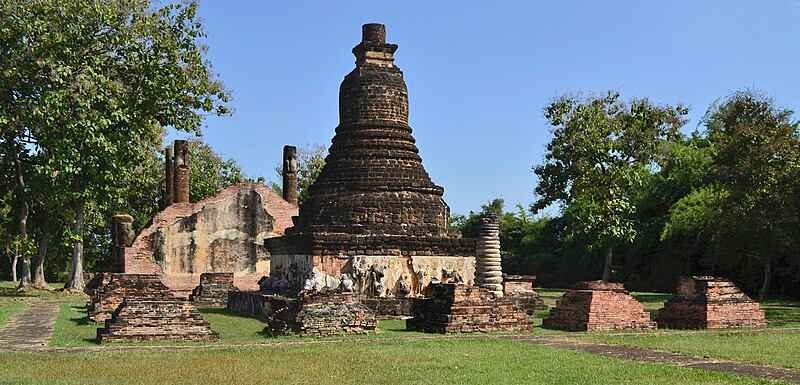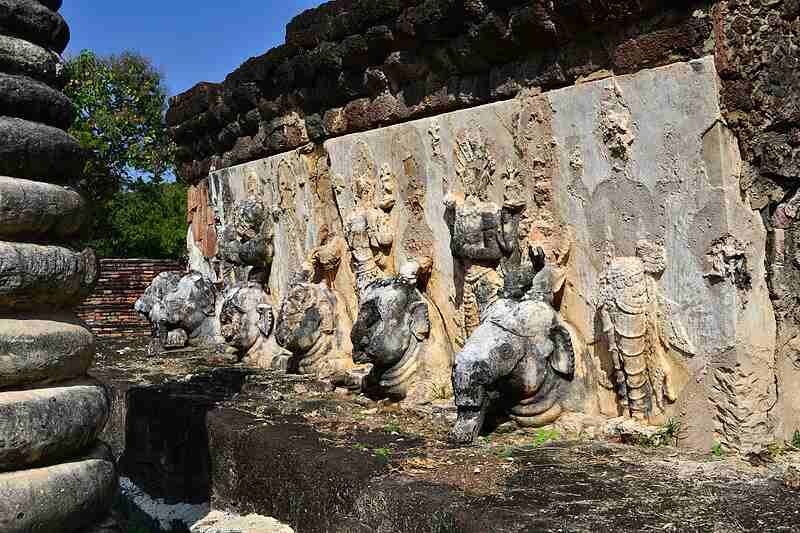Nestled within the serene landscapes of the Sukhothai Historical Park, Wat Chedi Si Hong stands as a testament to the architectural and cultural prowess of the Sukhothai Kingdom.
This temple, though not as grand as some of its counterparts, offers a unique charm and historical significance that captivates visitors.

History of Wat Chedi Si Hong
Wat Chedi Si Hong, also known as the “Temple of the Four Rooms,” was constructed in the late 14th or early 15th century.
This period marked the zenith of the Sukhothai kingdom, a time when art, culture, and religion flourished under the patronage of enlightened rulers. The temple’s name is derived from its architectural layout, which features four distinct sections.
Architectural Marvels of Wat Chedi Si Hong
The temple’s most prominent feature is its bell-shaped chedi, which, while not the most elegant in Sukhothai, is richly adorned with intricate stucco sculptures.
These decorations include elaborate reliefs depicting mythical creatures, floral patterns, and scenes from Buddhist lore. The base of the chedi is particularly noteworthy for its detailed stucco work, which showcases the artistic skills of the Sukhothai craftsmen.
To the east of the chedi lies the main assembly hall, or viharn, which houses the remains of several large stone columns.
These columns, though weathered by time, hint at the grandeur that once characterized the temple. The viharn also features the remnants of a seated Buddha image, adding a spiritual aura to the site.
Legends and Cultural Significance
While specific legends associated with Wat Chedi Si Hong are sparse, the temple’s location within the Sukhothai Historical Park imbues it with a rich cultural context.
The park itself is a UNESCO World Heritage Site, recognized for its historical and cultural importance. Wat Chedi Si Hong, like many other temples in the park, served as a center for religious activities and community gatherings during the height of the Sukhothai Kingdom.

Visiting Wat Chedi Si Hong
Visitors to Wat Chedi Si Hong can expect a serene atmosphere surrounded by lush greenery and historical remnants.
The temple’s relatively small size allows for an intimate exploration experience compared to larger complexes like Wat Mahathat.
Photography enthusiasts will find plenty of opportunities to capture the intricate details of the stucco reliefs and the overall beauty of the site.
For modern-day visitors, Wat Chedi Si Hong offers a tranquil escape into Thailand’s historical past.
The temple is located in the southern zone of the Sukhothai Historical Park, just across the road from Wat Chetuphon.
The best way to explore the temple and its surroundings is by taking a guided tour, which can provide deeper insights into the site’s history and significance.
The park itself is divided into five zones, each with its own set of ruins and historical sites.
While the central zone is the most visited, the southern zone, where Wat Chedi Si Hong is located, offers a quieter and more reflective experience.
Visitors can spend hours wandering through the ruins, taking in the serene beauty of the ancient structures and the lush greenery that surrounds them.
♣♣You May Also Like: ⇓
- Tremendous Sukhothai, Thailand: A Rich Historic Hub
- Fascinating Wat Saphan Hin: A Hilltop Haven in Sukhothai
- Attractive Wat Traphang Ngoen: The Jewel of Sukhothai
- Colossal Wat Phra Phai Luang: A Rich Journey
- Unique Devni Mori: A old and Lost Buddhist Heritage
Conclusion
Wat Chedi Si Hong may not be as renowned as some other temples in Sukhothai, but its unique artistic features and historical significance make it a worthwhile stop for anyone interested in Thailand’s rich cultural heritage.
Exploring this hidden gem offers a deeper understanding of the artistry that defined an important period in Thai history.
Its unique architectural features, coupled with its serene setting, make it a must-visit for anyone exploring the Sukhothai Historical Park.
As you walk through the temple grounds, you are not just witnessing the remnants of a bygone era but also connecting with the spiritual and cultural essence of the Sukhothai kingdom.